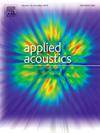Transfer–Function–Interpolated Control–Point augmentation for diffuse acoustic field synthesis
IF 3.4
2区 物理与天体物理
Q1 ACOUSTICS
引用次数: 0
Abstract
In the automotive, aerospace, and architectural acoustics fields, diffuse acoustic fields are employed to assess sound transmission through various materials. In the context of diffuse acoustic field synthesis using loudspeaker arrays, the conventional approach relies on establishing control points within the target area and measuring transfer functions between the loudspeakers and these points to optimize driving signals. This approach, however, guarantees accuracy only at the control points and results in increased errors elsewhere, while also requiring extensive transfer-function measurements. To enhance the global synthesis accuracy and reduce the measurement effort, we propose a statistical pressure-matching method enhanced by control-point augmentation with transfer-function interpolation. The proposed method increases the density of refined control points within the target region and employs a loudspeaker acoustic model to interpolate transfer functions throughout the entire synthesis area. The loudspeaker’s sound radiation is modeled as distinct pairs of monopole sources, positioned at segmented acoustic centers based on amplitude attenuation and phase delay. Experimental validation conducted with a 1D loudspeaker array in an anechoic chamber demonstrates that this approach achieves improved synthesis accuracy across the entire target region compared to traditional control-point-based methods, while substantially reducing the required number of transfer-function measurements.
扩散声场合成的传递函数插值控制点增强
在汽车、航空航天和建筑声学领域,漫射声场被用来评估声音通过各种材料的传播。在使用扬声器阵列进行漫射声场合成的情况下,传统的方法依赖于在目标区域内建立控制点,并测量扬声器与这些控制点之间的传递函数来优化驱动信号。然而,这种方法只能保证控制点的准确性,并导致其他地方的误差增加,同时还需要广泛的传递函数测量。为了提高全局合成精度和减少测量工作量,提出了一种基于传递函数插值的控制点增强的统计压力匹配方法。该方法增加了目标区域内精细控制点的密度,并采用扬声器声学模型在整个合成区域内插值传递函数。扬声器的声辐射被建模为不同的单极源对,基于幅度衰减和相位延迟定位在分段声中心。在消声室中使用1D扬声器阵列进行的实验验证表明,与传统的基于控制点的方法相比,该方法在整个目标区域内实现了更高的合成精度,同时大大减少了所需的传递函数测量次数。
本文章由计算机程序翻译,如有差异,请以英文原文为准。
求助全文
约1分钟内获得全文
求助全文
来源期刊

Applied Acoustics
物理-声学
CiteScore
7.40
自引率
11.80%
发文量
618
审稿时长
7.5 months
期刊介绍:
Since its launch in 1968, Applied Acoustics has been publishing high quality research papers providing state-of-the-art coverage of research findings for engineers and scientists involved in applications of acoustics in the widest sense.
Applied Acoustics looks not only at recent developments in the understanding of acoustics but also at ways of exploiting that understanding. The Journal aims to encourage the exchange of practical experience through publication and in so doing creates a fund of technological information that can be used for solving related problems. The presentation of information in graphical or tabular form is especially encouraged. If a report of a mathematical development is a necessary part of a paper it is important to ensure that it is there only as an integral part of a practical solution to a problem and is supported by data. Applied Acoustics encourages the exchange of practical experience in the following ways: • Complete Papers • Short Technical Notes • Review Articles; and thereby provides a wealth of technological information that can be used to solve related problems.
Manuscripts that address all fields of applications of acoustics ranging from medicine and NDT to the environment and buildings are welcome.
 求助内容:
求助内容: 应助结果提醒方式:
应助结果提醒方式:


